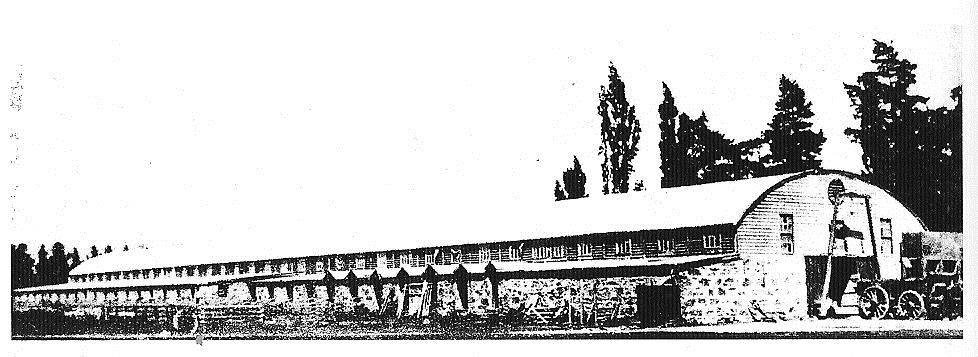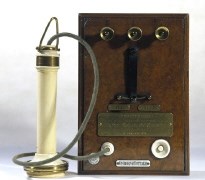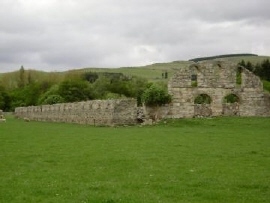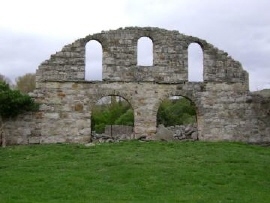Old Stones, First Phones (Central Otago) Traditional Geocache
Old Stones, First Phones (Central Otago)
-
Difficulty:
-

-
Terrain:
-

Size:  (small)
(small)
Please note Use of geocaching.com services is subject to the terms and conditions
in our disclaimer.
A roadside cache with a view of the Teviot Woolshed ruins.
These Old Stones were once the largest woolshed in New Zealand, possibly in the Southern Hemisphere; now it is the largest ruined stone building in New Zealand.
And First Phones? The first telephone call in New Zealand (perhaps*) was made here in 1877, between the Teviot Station homestead and Roxburgh Post Office.
Please note: the ruins are on private land and are not accessible. View from the roadside only.
You're looking for a one litre clear snaplock container. It's a slightly higher terrain rating because you'll have to get down on hands and knees, but she'll be apples.

The Teviot Run (number 199) was the first run applied for in Central Otago and gave its name to the Teviot Valley. This huge run lay on both sides of the Clutha (then known as the Molyneux), stretching from Dumbarton Rock to Fruitlands and up to the Obelisk on the summit of the Old Man Range on the west bank and from the Minzion Burn to Cave Creek and up to the Dismal Swamp (now Lake Onslow) on the east bank.
John Cargill†, the eldest son of William Cargill (co-founder of Dunedin) was granted the lease in 1857. In 1861 Cargill went into partnership with Edward R Anderson, son of Lady Anderson of London and a wealthy ex-officer of the British Army, who in 1872 married Cargill’s daughter Eliza. They also held the Umbrella Range (#369) and Campbell’s Creek (#425) runs. For the first 20 years the station was highly successful. It was famous for its well-bred Merino flock (85,000 sheep in 1875, according to shepherd Andrew Aitken) and high quality wool. Like other wealthy squatters Cargill and Anderson spent much of their time in Dunedin, leaving the station management in the capable hands of James Holms. He seems to have taken care of the pennies when it came to hiring shearers; in the Tuapeka Times 22 November 1873 it was reported that "Messrs Cargill and Anderson want 40 men, to whom they offer 15s per hundred", beginners preferred, while at Tapanui squatters were forced to offer their shearers 17s per hundred.
† It was John Cargill who had the tunnel at Tunnel Beach made, to give his daughters access to a private beach. His brother Edward Bowes built Cargills Castle.
The Teviot Woolshed was constructed in two stages. First, the north-eastern half was built of sandstone and plaster. There is no local sandstone; I wonder if it was imported as ship's ballast? This earlier building contained the shearing boards, wool storage and loading bays. The date is uncertain, with many sources suggesting the 1870s and Crawford proposing circa 1865.
The trusses and roofing iron for the semicircular woolshed roof were bought by Anderson on one of his trips “Home” and shipped back to New Zealand. Popular opinion in the district said that it came from the Glasgow Exhibition, but in 1924 W. Quinn stated in the Benger Mail that it was the roof of a temporary railway station. Perhaps the roof came from a temporary railway station built for the Glasgow Industrial Exhibition of 1865 - 1866? If so, the earliest the woolshed could have been built would be 1867.
In 1873 the south-western sheep-holding pens (which is what we see from the road) were added, built of the local schist and cement. The Tuapeka Times 27 March 1873 reported that the new building would be 200 feet by 50 feet (61 m x 15.2 m) and noted “This will make Messrs Cargill and Anderson’s the largest woolshed in the colony”.
“The largest woolshed...?” A fascinating article in the Tuapeka Times 8 December 1875 describing the management of Teviot Station says only that the woolshed was “gigantic” and “one of the largest and most complete establishments of the kind in Otago”. However, by the twentieth century it was one of the sights of the district, "said to be the largest in the Australasian colonies" Otago Witness 21 June 1905 and “claimed to be the largest in Australasia" Otago Witness 18 March 1908. More recently, Steven Eldred Grigg in “A Southern Gentry” says it was once the world’s largest woolshed. You can't get bigger than that!
 In 1948, Webster wrote in “Teviot Tapestry” that the woolshed measured 450 feet x 155 feet (137 m x 47.3 m) and was claimed to be the largest single storey shearing shed in the Southern Hemisphere. Roxburgh Jaycees included this information in a roadside sign they erected at Teviot (see wordpress) and it’s quoted in virtually every guidebook and tourist website: dayout, au.totaltravel, newzealand.com, wikimapia, otagocentralrailtrail, flightcentre, nzsouth, pleasetakemeto, digitalNZ, drivingholidayz.
In 1948, Webster wrote in “Teviot Tapestry” that the woolshed measured 450 feet x 155 feet (137 m x 47.3 m) and was claimed to be the largest single storey shearing shed in the Southern Hemisphere. Roxburgh Jaycees included this information in a roadside sign they erected at Teviot (see wordpress) and it’s quoted in virtually every guidebook and tourist website: dayout, au.totaltravel, newzealand.com, wikimapia, otagocentralrailtrail, flightcentre, nzsouth, pleasetakemeto, digitalNZ, drivingholidayz.
However, Crawford in “Tales from the Woolshed” measured the remaining ruins (the holding pens) as 45.5 m long x 25.86 m wide. The bulldozed part of the woolshed was 22.24 m wide. He thinks the length of the removed half is likely to have been at least 52 m, to bring the total length to at least 97.5 m. (The Teviot woolshed was known to be longer than the original 1870’s Moa Flat woolshed nearby. That was 97.5 m long x 21.3 m wide, “the second largest in the Southern Hemisphere”.) Was Teviot the largest woolshed in the Southern Hemisphere? It makes a good story, whether or not it’s true.
 On a trip to London in 1876 John Cargill met Alexander Graham Bell, who was demonstrating his newly-invented telephone to Queen Victoria. Hearing of the isolation of Teviot Station, Bell gave Cargill two telephones. The Roxburgh postmaster Thomas Coop, an experienced telegraphist, lay the line between the Post Office and the Teviot Station homestead on an unknown date in 1877. His daughter, Mrs Sheehy, is often said to have been the first person to have spoken on the phone. However, it is more likely that Cargill and the Postmaster Mr Coop held the first telephone conversation in New Zealand. Mrs Sheehy recounted only that when she was a girl she had spoken on the telephone on the first day it was used. It was reported in the Tuapeka Times 23 February 1878 that “Messrs Cargill and Anderson have a telephone connecting their lower station with the Roxburgh telegraph office” but no date is given for the installation.
On a trip to London in 1876 John Cargill met Alexander Graham Bell, who was demonstrating his newly-invented telephone to Queen Victoria. Hearing of the isolation of Teviot Station, Bell gave Cargill two telephones. The Roxburgh postmaster Thomas Coop, an experienced telegraphist, lay the line between the Post Office and the Teviot Station homestead on an unknown date in 1877. His daughter, Mrs Sheehy, is often said to have been the first person to have spoken on the phone. However, it is more likely that Cargill and the Postmaster Mr Coop held the first telephone conversation in New Zealand. Mrs Sheehy recounted only that when she was a girl she had spoken on the telephone on the first day it was used. It was reported in the Tuapeka Times 23 February 1878 that “Messrs Cargill and Anderson have a telephone connecting their lower station with the Roxburgh telegraph office” but no date is given for the installation.
* Alfred Bell of Shag Valley laid what is also said to be the first telephone line in New Zealand between the Shag Valley homestead and his brother's house, but no date is given so we’ll never know for sure. The first official phone call in NZ was from Dunedin to Milton on 2 February 1878.
The Great Snow followed by the big floods of 1878 halved the numbers of sheep, and therefore the wool clip. A world wide 17-year long depression triggered by the collapse of the City of Glasgow Bank led to a drop in demand for wool. The rabbit plague, which moved down from Clyde and appeared at Coal Creek in 1877, wiped out remaining profits for Cargill and Anderson as well as many other runholders. From 1883 Teviot was gradually sub-divided into smaller runs.
Cargill left for England in 1884 and then migrated to British Columbia in 1887, where he died in 1898.
Anderson moved to the Western Australia goldfields, returning to New Zealand later only to drown while swimming in the Mataura in 1906.
By 1924 the Woolshed was jointly used by all 12 farms of the post-WWI Teviot Settlement, and times were hard. There was an allegation that some of the wool stored in the shed was stolen, and a detective was to arrive up from Dunedin on the 12th November to investigate. But, the woolshed completely burnt down in the small hours of the morning of 11th November. Luckily, no sheep were in the shed (locals suggested they were released by the arsonist) and the buildings were insured. Evening Post 15 November 1924. The main suspect was proven to have been in the Maniototo on the 12th, and since he had no access to a car he was cleared of suspicion. Weeks later, a dead horse with the Teviot brand was found in the hills above Paerau; locals reckon that the suspect would have been leading a second horse to complete his escape. No-one was ever charged.
The entire woolshed walls stood until 1982 when sadly, the short-sighted property owner decided it was too expensive to stabilise the older sandstone walls and instead bulldozed that part of the ruins. He recalls that it was approximately half the length of the woolshed. What we see today is just the 1873 sheep holding pens. The ruins aren't the largest stone ruins (that would be the now-buried Hogburn sludge channel) but they are undoubtably the largest stone building ruins in New Zealand, and now have a category I Historic Places Trust registration.


Photos by Deanna and Rory, Millers Flat School
Acknowledgements: Thanks to Mussel-Care After School Care, St Kilda, Dunedin, for their gift of the hide and to Onslow Fisherman for suggesting the cache name.
Further information:
"Teviot Tapestry: A History of the Roxburgh-Millers Flat District" AHH Webster 1948
"Tales From The Woolshed" John Crawford 2006
"In Search of Central Otago" G Hugh Sumpter 1948
Historic Places Trust - Teviot Station Woolshed Ruins http://www.heritage.org.nz/the-list/details/336
Grownups New Zealand - Teviot Woolshed http://www.grownups.co.nz/read/travel/explore_new_zealand/the-teviot-woolshed Allan Dick
"The New Zealand Heritage of Farm Buildings" Geoffrey G Thornton 1986
Living Heritage: Schools' Stories - Millers Flat School – Teviot Woolshedhttp://www.livingheritage.org.nz/Schools-Stories/Historical-treasures-of-Millers-Flat/Teviot-Woolshed
The stories of two Teviot shepherds, Andrew Aitken (1875-79) and N Robson (1880s) are included as the earliest log notes on this page. Scroll down to read them.
NZ History: Internet in NZ timeline https://www.nethistory.co.nz/Internet_in_New_Zealand_Timeline/
I've found only snippets about the Glasgow Industrial Exhibition, but here's a bronze medal from the Exhibition. The exhibition hall was at 99 Argyle St, in what became the Polytechnic. The Exhibition of Arts and Industry was opened on 12 December 1865 by the Duke of Argyll. “It commanded great attention in Scotland and other parts of the kingdom, and retained its popularity till its close” on 31 March 1866. Another that caught my eye was the illustrated record of the 1865 Dublin International Exhibition with pictures of the 50' 6" wide nave and roof girder. These temporary buildings would certainly be an ideal source for a woolshed roof.
John Cargill's previous run was #54, Tuapeka. In 1861 Gabriel Read accompanied by Captain William Baldwin discovered payable gold at Waitahuna, and the Tuapeka run was declared a goldfield. Cargill went to court and got 3000 pounds compensation; as well as losing the run, his wooden woolshed at Tuapeka had been demolished by gold diggers using the wood to make goldmining equipment.
Additional Hints
(Decrypt)
ByqFgbar onfr Nccyr Gerr